初三中考英语语法专题复习之情态动词讲义教案
初中英语语法之情态动词

常用的情态动词有can,may,must,need,should, had better.
1. can的用法:
①表示能力“能,会”eg: He can speak a little Japanese.他会说一点日语。
We can be there on time tomorrow.我们明天能按时去那儿。
最大,其余依次递减。肯定句中表推测“一定,肯定”用must.
1.He must/can/may,might know the answer to this question.
他一定/可能/也许知道这个问题的答案。
2.It is cold in the room. They must have turned off the heating.
一对一辅导教案
学生姓名
性别
年级
九年级
学科
Байду номын сангаас英语
授课教师
上课时间
年月日
第()次课
共()次课
课时:课时
教学课题
情态动词
教学目标
教学重点与难点
教学过程
知识梳理
情态动词
情态动词是一种本身有一定的词义,但要与动词原形及其被动语态一起使用,给谓语动词增添情态色彩,表示说话人对有关行为或事物的态度和看法,认为其可能、应该或必要等。情态动词后面加动词原形。情态动词无人称和数的变化,情态动词后面跟的动词需用原形,否定式构成是在情态动词后面加"not"。
注意:①could也可表示请求,语气委婉,主要用于疑问句,不可用于肯定句,答语应用can(即could不能用于现在时态的简略答语中)。如:
Could I come to see you tomorrow?
英语人教版九年级全册情态动词复习教案

专题九情态动词课前复习[中考名题体验]1. — Finally, they came back.— They ______be hungry after such a long walk.A.can’t B.must C.needn’t2. —Mum, I’m going climbing. Must I clean the room now?—No, you_____________. You can do it this evening.A. c an’tB. mustn’tC. needn’t3. The passengers ______ show their ID cards before getting on the plane.A. mightB. mustC. could4.--Mum, ______ I visit the Science Museum tomorrow?--I'm afraid you can't. It is closed on Monday.A. mustB. mayC. should学习目标1、掌握情态动词的意义2、掌握常见情态动词can,could,may,might,must,haveto,shall,will,should,would,need等的用法3、认真领会情态动词can(could), must, may,might,shall,should ,will(would) , need, have to等各个相近情态动词间的区分.4、教学重难点: 各个情态动词的用法区分.教学步骤一、情态动词本身有一定的意义,但它们没有人称和数的变化,不能单独使用,须和动词一起构成句子的谓语,表示说话的情感、态度和语气。
常用的情态动词有can,could,may,might,must,have to,shall,will,should,would,need等。
第03讲 情态动词(讲义)-中考英语一轮复习讲练测(全国通用)(学生版)_1
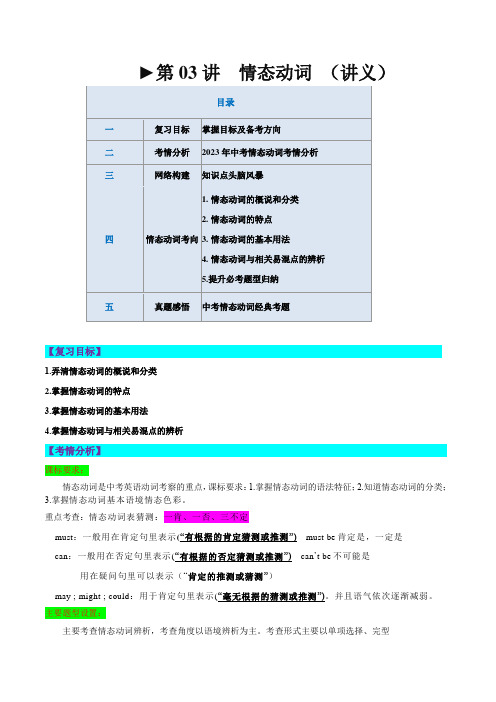
►第03讲情态动词(讲义)目录一复习目标掌握目标及备考方向二考情分析2023年中考情态动词考情分析三网络构建知识点头脑风暴四情态动词考向1.情态动词的概说和分类2.情态动词的特点3.情态动词的基本用法4.情态动词与相关易混点的辨析5.提升必考题型归纳五真题感悟中考情态动词经典考题【复习目标】1.弄清情态动词的概说和分类2.掌握情态动词的特点3.掌握情态动词的基本用法4.掌握情态动词与相关易混点的辨析【考情分析】课标要求:情态动词是中考英语动词考察的重点,课标要求:1.掌握情态动词的语法特征;2.知道情态动词的分类;3.掌握情态动词基本语境情态色彩。
重点考查:情态动词表猜测:一肯、一否、三不定must:一般用在肯定句里表示(“有根据的肯定猜测或推测”)must be肯定是,一定是can:一般用在否定句里表示(“有根据的否定猜测或推测”)can’t be不可能是用在疑问句里可以表示(“肯定的推测或猜测”)may ; might ; could:用于肯定句里表示(“毫无根据的猜测或推测”)。
并且语气依次逐渐减弱。
主要题型设置:主要考查情态动词辨析,考查角度以语境辨析为主。
考查形式主要以单项选择、完型填空、短文填空及语法填空为主。
情态动词题型命题规律【网络构建】情态动词是初中英语里的一个重要的语法项目,也是全国各省市中考试题的考查热点。
在备战2024年中考时,考生要牢记情态动词的结构和意义以及其表示推测时的用法,多做练习,在实践中加以区分。
(一)概说情态动词表示说话人的语气和观点.情态动词有一定的词义,但不能单独作谓语,它必须和表示动作或状态的不带to 的不定式(ought 除外)连用,构成复合谓语.情态动词只有情态意义,即它表示说话人对动作的观点,如需要、可能、意愿或怀疑等.情态动词主要有:can(could),may(might),must, ought to, need, dare(dared), have to(had to).此外shall, will, should, would 在一定场合下也可用作情态动词.(二)情态动词的分类:(1)只作情态动词:must;can/could;may/might;ought to(2)既可作情态动词又可作实义动词:need,dare(3)既可作情态动词又可作助动词:shall/should;will/would(4)具有情态动词某些特征:have/had to;had better考向二 情态动词的特点(1)情态动词无人称和数的变化(have to 除外);(2)情态动词后接动词原形;(3)情态动词的否定式是在其后加not; have to 除外(4)具有助动词的作用,可用来构成否定句、疑问句及用于简明答语;(5)个别情态动词有现在式和过去式两种形式,过去式用来表达更加客气、委婉的语气,时态性不强,可用于过去、现在或将来。
九年级英语教学设计导学案(情态动词)

t; can 14.—The book report is very important. You ________ write it carefully. —But I ________ hand it in now. A.must; must B.have to; must C.must; have to D.have to; have to 15.It is 11:00 p.m now. Peter hasn't come back yet. His mother ______ be very mad
三、加强思维
6.I’ve bought a nice necklace for Jo’s birthday. She _____like it, but I’m not sure. A.can B.may be C.might D.must 7.The designer has tried every possible way to make the robot light, so you _____
导学设计
9.—Can we walk across the road now?
—No, we. We have to wait until the light turns green.
A.couldn’t B.needn’t C.shoul heard about the temperature of the earth will rise to 59℃ in 2020?
at him. A.may
B.can
C.must
D.need
1-5:BDCAA 6-10:CDADB 11-15:BCDCC
2/3
导学设计
3/3
人教版中考英语语法专题—情态动词教案

人教版中考英语专题—情态动词教案1. I ______ follow you. Would you please repeat it?A. can’tB. mustn’tC. needn’tD. shouldn’t2. —Must I hand in my homework now, Mr. Smith?—No, you _______.A. can’tB. shouldn’tC. wou ldn’tD. needn’t3. —Excuse me, may I keep the book a little longer?—Sorry. You ________ return it today.A. mustB. mustn’tC. canD. can’t4. —Is the man over there Mr. Brown?—It ______ him. He has gone to Brazil to watch the 2014 FIFA World Cup.A. may notB. can’t beC. shouldn’tD. mustn’t5. Children _______ si t in the front seat of a car. It’s too dangerous.A. needB. needn’tC. mustD. mustn’t情态动词有具体的词义,但也同助动词一样,需要与其他词语一起构成句子的谓语,另外情态动词没有人称和数的变化,情态动词后必须跟动词原形。
考点一:can,may,must等情态动词在陈述句中的用法:1. can的用法:(1)表示能力、许可、可能性。
表示能力时一般译为“能、会”,即有种能力,尤其是生来具备的能力,此时may和must均不可代替它。
如:She can swim fast, but I can’t.(2)表示许可,常在口语中。
如:You can use my dictionary.(3)表示推测,意为“可能”,常用于否定句和疑问句中,此时can’t译为“不可能”。
中考英语 情态动词复习教案(表格式)
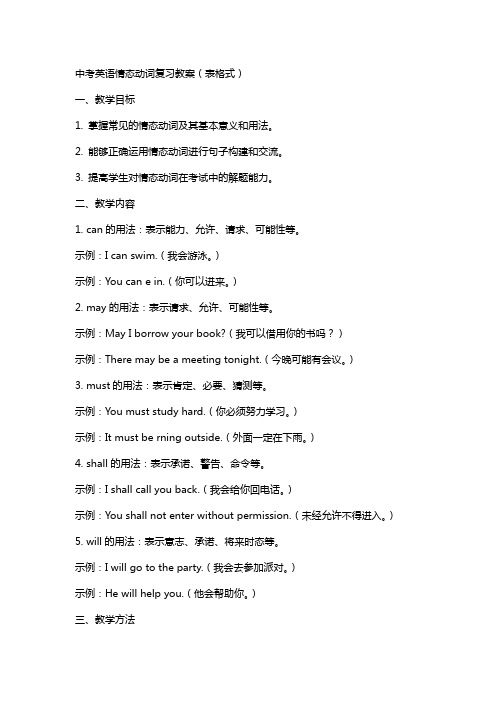
中考英语情态动词复习教案(表格式)一、教学目标1. 掌握常见的情态动词及其基本意义和用法。
2. 能够正确运用情态动词进行句子构建和交流。
3. 提高学生对情态动词在考试中的解题能力。
二、教学内容1. can的用法:表示能力、允许、请求、可能性等。
示例:I can swim.(我会游泳。
)示例:You can e in.(你可以进来。
)2. may的用法:表示请求、允许、可能性等。
示例:May I borrow your book?(我可以借用你的书吗?)示例:There may be a meeting tonight.(今晚可能有会议。
)3. must的用法:表示肯定、必要、猜测等。
示例:You must study hard.(你必须努力学习。
)示例:It must be rning outside.(外面一定在下雨。
)4. shall的用法:表示承诺、警告、命令等。
示例:I shall call you back.(我会给你回电话。
)示例:You shall not enter without permission.(未经允许不得进入。
)5. will的用法:表示意志、承诺、将来时态等。
示例:I will go to the party.(我会去参加派对。
)示例:He will help you.(他会帮助你。
)三、教学方法1. 实例讲解:通过具体例句讲解每个情态动词的用法。
2. 表格对比:列出各情态动词的用法表格,进行对比分析。
3. 练习巩固:设计相关练习题,让学生巩固所学内容。
4. 小组讨论:分组讨论情态动词的用法,促进学生互动。
四、教学步骤1. 导入:简要介绍情态动词的概念及重要性。
2. 讲解:分别讲解每个情态动词的用法,并结合实例演示。
3. 对比:展示各情态动词用法表格,让学生进行对比分析。
4. 练习:设计练习题,让学生进行课堂练习。
5. 讨论:分组讨论练习题,引导学生互相交流心得。
情态动词教学案例中考英语备考必备

情态动词教学案例 - 中考英语备考必备为了中考英语成绩更好,很多学生选择进行系统的备考。
而作为中考英语的一大重点——情态动词的掌握可谓是很重要的。
在这篇文章中,我们将会为大家展示一组情态动词教学案例,帮助他们更好地掌握情态动词的出现和用法。
一、教学目标1.掌握情态动词的本用法和出现方式。
2.学会如何在各种语言环境中正确运用情态动词。
二、教学内容1.了解情态动词的基本概念和用法。
情态动词是指在句子中表示说话人的态度、意见、推测、建议、请求、允许、必须等情感和意愿的词语,它们通常与动词原形连用,而且没有时态和人称的变化。
例如:can,could,may,might,shall,should,will,would等等。
2.掌握情态动词在不同语境下的具体使用。
情态动词在不同语境中使用有明确的规则,以下是一些常见的情态动词的用法和出现方式:1)can/could表示能力或允许。
例如:I can swim. 我会游泳。
2)may/might表示可能性或问询请求。
例如:May I help you? 我能帮助你吗?3)must表示强烈的义务、必须。
例如:We must study hard. 我们必须努力学习。
4)should表示议论、建议、责任等。
例如:You should go to bed early. 你应该早点睡觉。
5)will/would表示意愿、约定、习惯等。
例如:I will go to the park tomorrow. 明天我会去公园。
三、教学过程1.情景教学教师可以根据不同的情景设计一些教学活动,来协助学生更好地掌握情态动词。
例如:在购物的情境中,老师可以设计问答环节:A: Can I help you?B: Yes, I want to buy some apples.A: How many do you want?B: I want to buy five.2.语境教学情态动词的运用需要考虑到具体的语境,为此,教师可以设计图片、短话、文章,让学生感性认识到情态动词在不同语境中的典型用法,比如:图片教学教师可以准备一些反映具体情感和意愿的图片,让学生通过形象的图像来理解情态动词在不同语境中的具体运用,比如:短话教学教师可以给学生一些简短的话,让他们理解情态动词在不同语境中的意义和基本用法,例如:1)Can you help me lift the box?2)We should protect the environment.3)He will finish his homework before ten o'clock.文章阅读教师可以让学生阅读一些文章,让他们更全面地了解情态动词在不同语境中的使用情况,例如:四、教学方法1.语境优先情态动词在语境中的意义更加明确,因此,我们应该优先学习语境。
九年级英语全册情态动词复习教案1人教新目标版

九年级英语全册情态动词复习教案1⼈教新⽬标版⼭东省⾼唐县实验中学九年级英语全册情态动词复习教案1 ⼈教新⽬标版【注】回答带有may的疑问句时,否定式常⽤must not(mustn’t),表⽰“不可以”、“禁⽌”的意思 e.g.—May I take this magazine out of the reading-room?—No, you mustn’t.表⽰说话⼈的猜测,认为某⼀件事“或许”、“可能”发⽣e.g. You may be right.Might也可以代替may,表⽰现在时间的动作,但语⽓较为婉转客⽓或更加不肯定e.g. It might rain this afternoon.情态动词must和have to的⽤法表⽰“必须”,“应当” e.g. We must be strict in our work.must的否定形式must not\mustn’t,表⽰“不可以”、“禁⽌”的意思,语⽓⽐较强烈。
回答must的疑问句时,否定式常⽤need not\needn’t或don’t have,表⽰“不必”、“⽤不着” e.g.—Must we hand in our exercise today?—No,you needn’t.表⽰说话⼈对事物的推测,⽐may语⽓肯定得多,意为“⼀定”、“准是”e.g. She must know how to solve the problem.have to表⽰“不得不”、“必须”的意思,它⽐must更含有“客观条件时的必须如此做”的意思,并有较多的时态e.g. She has to do a lot of housework every day.情态动词should的⽤法表⽰劝告、建议,常译为“应当” e.g. You should listen to the doctor’s advice.表⽰预测,常译为“可能” e.g. They should be here by now.情态动词need的⽤法need作为情态动词,主要⽤于否定句和疑问句中,表⽰“需要”、“必须”e.g. You needn’t come here so earl y tomorrow.need可⽤作实义动词,其否定形式要借助don’t,doesn’t 或didn’t;疑问形式要借助do,does或did e.g. Do you need any help?情态动词will\would的⽤法⽤于疑问句,⼀般⽤于第⼆⼈称,表⽰说话⼈向对⽅提出请求或询问e.g. Will you have another cup of coffee?表⽰“意愿”、“决⼼”等,可⽤于各种⼈称 e.g. I’ll do my best.⽤would时语⽓⽐will委婉 e.g. Would you please pass me the ruler?情态动词shall的⽤法在疑问句中,情态动词shall⽤于第⼀、三⼈称,表⽰说话⼈征求对⽅的意见或向对⽅请⽰ e.g. Shallwe go out for a walk?短语动词的类型动词+介词(⽤作及物动词,后跟宾语),此类短语动词有wait for,look for,look after,look at,look into,agreeto,agree with,hear from等 e.g. He looked afterus very well.动词+副词(有的⽤作及物动词,有的⽤作不及物动词),此类短语有find out,give up,hand in,hurry up,knock down,leave behind,look out,look up,put on,slow down,think over,try on,try out,wake up,work out等e.g. He called up the man.【注】当这类短语动词的宾语是名词时,它可以置于短语动词之后,置于短语动词之中。
情态动词 教案 -2021-2022学年九年级英语中考研讨复习专题

It must belong to Carla情态动词教学设计I.Analysis of the Teaching Materials情态动词(Modal verbs)本身有一定的词义,表示语气的单词。
但是不能独立作谓语,只能和动词原型一起构成谓语。
情态动词用在行为动词前,表示说话人对这一动作或状态的看法或主观设想。
情态动词虽然数量不多,但用途广泛。
先结合七年级和八年级的情态动词教材,用can/coul d做例子,教学其用法;再结合九年级的教材,引出might/must /can’t等情态动词,最后一起总结情态动词的用法。
II.Analysis of the Students学生对情态动词有一定的了解,但不够全面和深刻,有些学生甚至已经忘记某些情态动词及其相应的用法。
III.Learning and teaching Objectives1.知道情态动词有哪些;2.掌握情态动词can ,may,must的用法;3.掌握情态动词could,might,have to等等的用法IV.Key points and predicted difficultyKey points:1.知道具体的情态动词;2.了解并掌握情态动词的运用。
Predicted difficulty:部分学生不能正确使用情态动词。
V.Blackboard DesignCan-------couldMay------mightMust-----mustNeed----neededShall----shouldWill-----wouldHave to--had toHad better---had better七、学习过程:VI. Activities1.Listen to the song and answer the questions.1.Play thesong and asksomequestions.1.Students can listen tothe s ong and answerthe questions.2.Look at the pictures and tryto answer the questions.3.Look at the pictures andplay the guessing game.2.Show somepictures and let 2.Students can practisethe conversations andknow how to use “canand could”.3.Students can playthe guessing game andknow how to use“can’t/might/must”2.To practise speaking Englishand try to know “can and could”.3.To play the game and try toknow “can’t/might/must”.4.Learn the other Modal 4.To know Modal verbs and usethem correctly.Look at or read a ll the Modal verbs again and try to remember them, then try to use them correctly.2022.5.11-12。
英语语法教学微课教案(情态动词can和could)
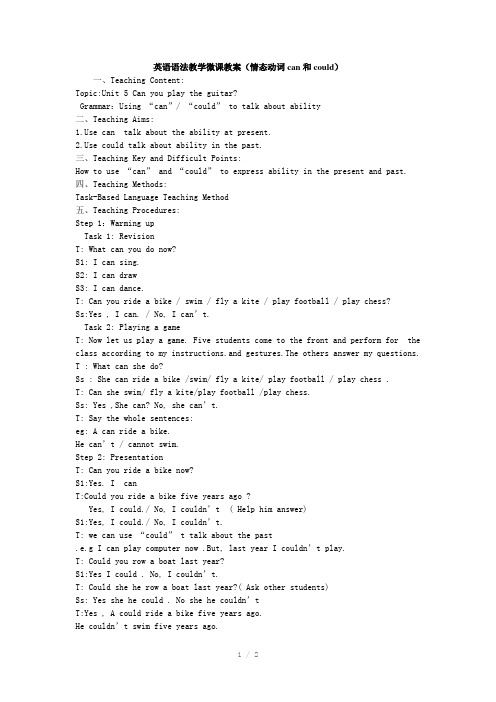
英语语法教学微课教案(情态动词can和could)一、Teaching Content:Topic:Unit 5 Can you play the guitar?Grammar:Using “can”/ “could” to talk about ability二、Teaching Aims:e can talk about the ability at present.e could talk about ability in the past.三、Teaching Key and Difficult Points:How to use “can” and “could” to express ability in the present and past.四、Teaching Methods:Task-Based Language Teaching Method五、Teaching Procedures:Step 1:Warming upTask 1: RevisionT: What can you do now?S1: I can sing.S2: I can drawS3: I can dance.T: Can you ride a bike / swim / fly a kite / play football / play chess?Ss:Yes , I can. / No, I can’t.Task 2: Playing a gameT: Now let us play a game. Five students come to the front and perform for the class according to my instructions.and gestures.The others answer my questions. T : What can she do?Ss : She can ride a bike /swim/ fly a kite/ play football / play chess .T: Can she swim/ fly a kite/play football /play chess.Ss: Yes ,She can? No, she can’t.T: Say the whole sentences:eg: A can ride a bike.He can’t / cannot swim.Step 2: PresentationT: Can you ride a bike now?S1:Yes. I canT:Could you ride a bike five years ago ?Yes, I could./ No, I couldn’t ( Help him answer)S1:Yes, I could./ No, I couldn’t.T: we can use “could” t talk about the past.e.g I can play computer now .But, last year I couldn’t play.T: Could you row a boat last year?S1:Yes I could . No, I couldn’t.T: Could she he row a boat last year?( Ask other students)Ss: Yes she he could . No she he couldn’tT:Yes , A could ride a bike five years ago.He couldn’t swim five years ago.1 / 2(Teach the students to say the whole sentences):A could ride a bike five years ago.He couldn’t swim five years ago.)(Ask other students in the same ways)Step 3: Practice :work in pairsT: Ask your partner more questionseg: Could he / she …?(Yes, he / she could. / No, he / she couldn’t.)...Step 4: ProductionTask 3: ExplanationT: Let’s work out the rule.①肯定句式: can\ could②否定句式: can’t\ couldn’t③疑问句式: Can …?\Could …?T: We can use “am (is , are) able to “ instead of “can”,and “was (were) able to “ instead of “could“.eg.①Mike can sing more than 20 English songs.Mike is able to …②She could speak English when she was four.She was able to…T: Please give more examples.to practice them.Step 5: SummaryT:In this class, we have learnt the use of can and could about talking about abilities .Who knows the differences between “can” and “could”Step 6: HomeworkFinish off the practice on the workbooks ,Fill in the blank with can/could。
初中will用法教案

初中will用法教案1. 知识目标(1)使学生掌握情态动词will的基本用法。
(2)使学生能够正确运用will表示将来时态。
(3)使学生能够理解will在表示意志、允诺、警告、命令等情境中的用法。
2. 能力目标(1)提高学生运用情态动词will进行口语交流的能力。
(2)培养学生运用will写句子的能力。
3. 情感目标激发学生学习英语的兴趣,培养积极的学习态度。
二、教学重难点1. 教学重点(1)情态动词will的基本用法。
(2)will表示将来时态的构成和用法。
(3)will在表示意志、允诺、警告、命令等情境中的用法。
2. 教学难点(1)will表示将来时态的运用。
(2)will在表示意志、允诺、警告、命令等情境中的运用。
三、教学步骤1. 导入(1)教师与学生用英语进行日常交流,引导学生回顾已学过的情态动词。
(2)提问:你们知道哪些情态动词?它们有什么用法?2. 呈现(1)教师板书情态动词will,并向学生介绍其基本用法。
(2)教师通过例句展示will表示将来时态的构成和用法。
(3)教师通过例句展示will在表示意志、允诺、警告、命令等情境中的用法。
3. 操练(1)教师组织学生进行小组活动,让学生用will编写句子,并互相交流。
(2)教师选取一些学生的句子进行展示和点评。
4. 巩固(1)教师设计一些情境,让学生运用will进行角色扮演。
(2)教师布置课后作业,让学生运用will完成句子或短文。
5. 总结教师对本节课的内容进行总结,强调will的重要性和用法。
四、课后作业1. 用will完成以下句子:(1)我明天____去图书馆。
(2)她____给我们带来一些水果。
(3)如果你需要帮助,我____尽力帮助你。
2. 运用will写一段短文,描述你未来的计划。
五、教学反思在教学过程中,要注意关注学生的学习情况,及时发现并解决问题。
针对学生的不同需求,可以适当调整教学方法和节奏。
在课后,要及时批改作业,给予学生反馈,帮助他们巩固所学知识。
初三中考英语语法专题复习之情态动词讲义教案
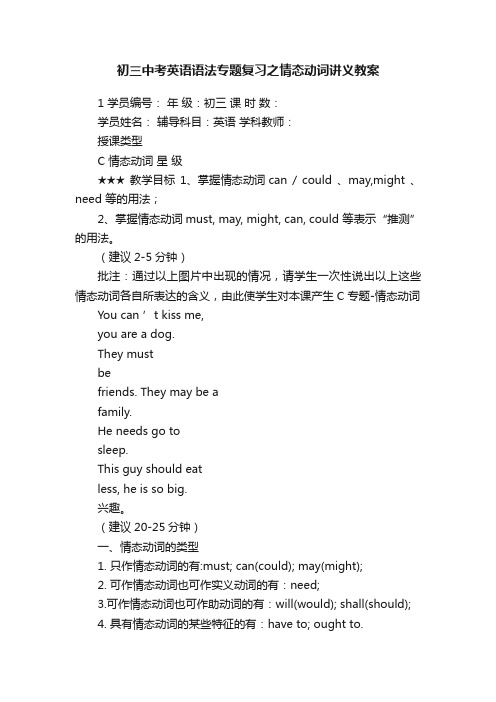
初三中考英语语法专题复习之情态动词讲义教案1 学员编号:年级:初三课时数:学员姓名:辅导科目:英语学科教师:授课类型C 情态动词星级★★★ 教学目标1、掌握情态动词can / could 、may,might 、need 等的用法;2、掌握情态动词must, may, might, can, could 等表示“推测”的用法。
(建议2-5分钟)批注:通过以上图片中出现的情况,请学生一次性说出以上这些情态动词各自所表达的含义,由此使学生对本课产生C 专题-情态动词You can ’t kiss me,you are a dog.They mustbefriends. They may be afamily.He needs go tosleep.This guy should eatless, he is so big.兴趣。
(建议20-25分钟)一、情态动词的类型1. 只作情态动词的有:must; can(could); may(might);2. 可作情态动词也可作实义动词的有:need;3.可作情态动词也可作助动词的有:will(would); shall(should);4. 具有情态动词的某些特征的有:have to; ought to.批注:关于对情态动词类型的分析,只能针对基础较好的学生,基础差的学生一般很难理解上述的总结:关于第三点的解释—will 和shall作助动词可以用于将来时的构成中,shall一般只用于主语是第一人称的时候,would 和should则为过去将来时的构成;关于第四点的解释—have to 是有时态和三单形式的变化的,ought to 在变疑问句和否定句时,to 是被排除在外不作考虑的。
二、情态动词的特征1. 有一定的词义,但不能单独作谓语,必须和行为动词或系动词连用,构成谓语。
2. 无人称和数的变化(have to例外,用于第三人称单数时用has to).例:We must stay here.我们必须待在这儿。
中考英语语法复习方案6--情态动词

中考英语语法复习方案6《情态动词》【趋势解读】情态动词是各地中考的必考点,主要考查情态动词的基本用法,考题贴近生活实际,体现语言学习的实用性。
要求考生熟知情态动词的基本特点,掌握常见倩态动词的各种用法。
考生答题时需认真体会语境,揣摩说话者的语气强弱和态度。
难度适中,一般分值在1}2分。
预计中考关于本专题知识命题趋势如下:(1)各地中考情态动词考查的热点为表推测、许可及义务含义的情态动词,尤其是对must 三种用法的考查是重中之重。
(2)自主招生考试的重点将关注情态动词表示推测的用法及情态动词与现在完成时连用。
分值为1~2分。
【思维引导】精彩笔记1 表示能力的情态动词注意:表示具有某种能力的还有半情态动词be able to,但是和can有区别,can只有现在式和过去式。
be able to可以有更多的时态。
核心题根1 (1) I'm going to Europe on vacation together with John if I find the money.A. canB. mightC. wouldD. need思路点拨:①考查情态动词表示能力。
②句意:如果我现在能有足够的钱,我将和John一起去欧洲度假。
③ can“能,会”,表示体力、智力、技能方面的能力;might“可能,可以”,表示可能性推测;would“愿意”;need“需要”,表示必要。
(2)—No one be compared with Yao Ming in playing basketball.—Oh,you are really his big fan.A. canB. needC. mustD. might思路点拨:①句意:—在打篮球方面没有人能和姚明相比。
—你真是他忠实的粉丝。
②此处应填表示能力的情态动词。
can“能,会”,表示能力;need“需要”;must“必须”,表示义务;might“可以,可能”,表示请求许可或可能性的推测。
中考英语 情态动词复习教案(表格式)
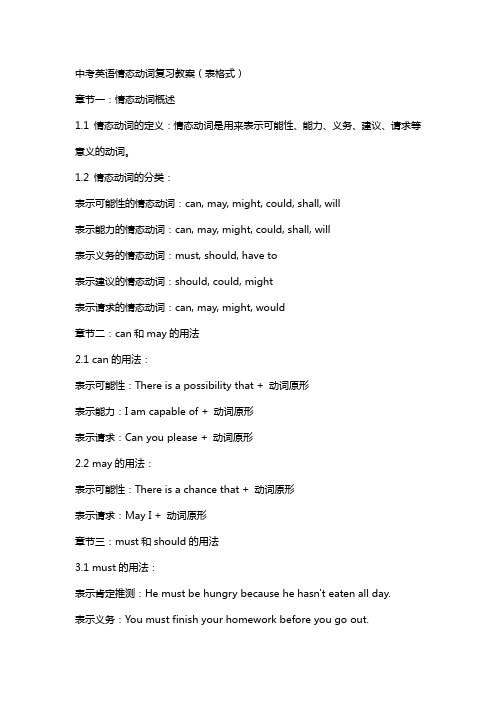
中考英语情态动词复习教案(表格式)章节一:情态动词概述1.1 情态动词的定义:情态动词是用来表示可能性、能力、义务、建议、请求等意义的动词。
1.2 情态动词的分类:表示可能性的情态动词:can, may, might, could, shall, will表示能力的情态动词:can, may, might, could, shall, will表示义务的情态动词:must, should, have to表示建议的情态动词:should, could, might表示请求的情态动词:can, may, might, would章节二:can和may的用法2.1 can的用法:表示可能性:There is a possibility that + 动词原形表示能力:I am capable of + 动词原形表示请求:Can you please + 动词原形2.2 may的用法:表示可能性:There is a chance that + 动词原形表示请求:May I + 动词原形章节三:must和should的用法3.1 must的用法:表示肯定推测:He must be hungry because he hasn't eaten all day.表示义务:You must finish your homework before you go out.3.2 should的用法:表示建议:You should study more if you want to pass the exam. 表示义务:You should help your parents with household chores. 章节四:情态动词的否定和疑问句4.1 否定句:can的否定句:I can't speak French.may的否定句:You may not leave the classroom now.must的否定句:You must not eat before the exam.should的否定句:You should not stay up late.4.2 疑问句:can的疑问句:Can you help me with this?may的疑问句:May I borrow your book?must的疑问句:Must you leave now?should的疑问句:Should we go to the park?章节五:情态动词的时态5.1 情态动词的一般现在时:can的现在时:I can swim.may的现在时:She may e to the party.must的现在时:He must finish his work.should的现在时:You should study every day.5.2 情态动词的一般过去时:can的过去时:I couldn't answer the question.may的过去时:She may have finished her homework.must的过去时:He must have left the house.should的过去时:You should have studied for the exam.章节六:情态动词的被动语态6.1 情态动词的被动语态构成:情态动词+ be + 过去分词6.2 被动语态的用法:can的被动语态:The window can be opened.may的被动语态:The letter may be written him.must的被动语态:The door must be locked.should的被动语态:The report should be submitted tomorrow.章节七:情态动词的短语搭配7.1 can的短语搭配:can't help but + 动词原形:I can't help but laugh when I see him.can't do anything about:We can't do anything about the weather.7.2 may的短语搭配:may as well + 动词原形:I may as well go to the party.may not have + 动词过去分词:She may not have finished her homework. 章节八:情态动词的考试题型8.1 选择题:选出正确的情态动词填空:He ____________ finish his work on time. (can, may, must, should)8.2 填空题:根据语境选择合适的情态动词填空:If you ____________ be quiet, you will pass the exam. (can, may, must, should)章节九:情态动词的实战练习9.1 编写一段对话:使用不同情态动词编写一段日常对话,例如:A: Can you help me with this?B: Yes, I can. Here you are.9.2 改写句子:Original: He is taller than his brother.Revised: He ____________ be taller than his brother. (can, may, must, should)章节十:情态动词的综合复习10.2 情态动词的测试:设计一份情态动词的测试,包括选择题、填空题、改写句子和对话编写等题型,以检验学生对情态动词的综合掌握情况。
外研版中考英语语法复习专题--情态动词教案

(二)情态动词的种类:(见下表)
原形
过去式
词义
can
could
能
may
might
可以(或许)
must
must(had to)
必须(不得不)
will
would
愿意
shall
should
应该
(三)情态动词的否定形式:
cannot --- can’tcould not --- couldn’tmay not--- mayn’t
(考点1,情态动词的本身含义表格中常考的情态动词均有现在和过去,用法:1、表过去式,用于疑问句中,语气比较委婉)
(四)常用情态动词的用法:(考点2情态动词的常规考法和特殊考法)
1.can与could
1).can
(1)表示体力或脑力方面的“能力”,也能表示根据客观条件能做某事的“能力”。
He can drive.
(1)can的过去式,表示过去有能力及过去的可能性。
He couldn’t climb up the mountain.
The news could be true.
(2)表示客气地请求或委婉地陈述意见。
Could you go skating with me tomorrow?
I’m afraid I couldn’t give you an answer tonight.
2) need引导的疑问句,肯定回答时多用must,否定回答时用needn’t。
Need he come? Yes, he must.No, he needn’t.
3) need后接名词做宾语时,表示“需要”某件事物,此时用作实义动词,与一般的实义动词用法完全一样,有时态和数的变化。如:
中考英语备考语法专题 情态动词could的使用归纳 讲与练
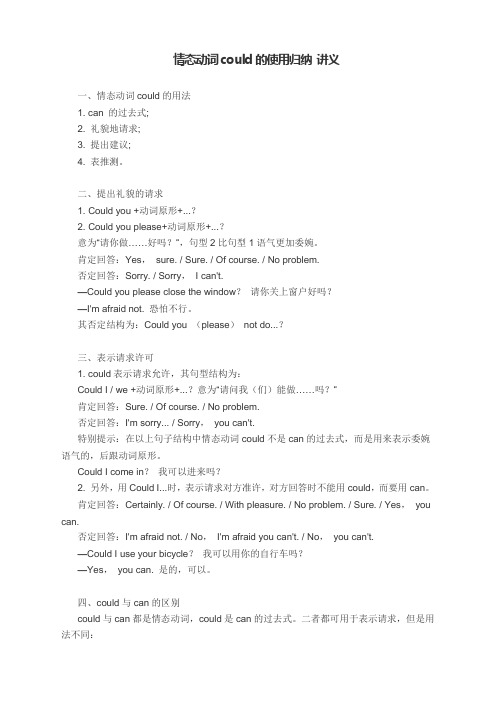
情态动词could的使用归纳讲义一、情态动词could的用法1. can 的过去式;2. 礼貌地请求;3. 提出建议;4. 表推测。
二、提出礼貌的请求1. Could you +动词原形+...?2. Could you please+动词原形+...?意为“请你做……好吗?”,句型2比句型1语气更加委婉。
肯定回答:Yes,sure. / Sure. / Of course. / No problem.否定回答:Sorry. / Sorry,I can't.—Could you please close the window?请你关上窗户好吗?—I'm afraid not. 恐怕不行。
其否定结构为:Could you (please)not do...?三、表示请求许可1. could表示请求允许,其句型结构为:Could I / we +动词原形+...?意为“请问我(们)能做……吗?”肯定回答:Sure. / Of course. / No problem.否定回答:I'm sorry... / Sorry,you can't.特别提示:在以上句子结构中情态动词could不是can的过去式,而是用来表示委婉语气的,后跟动词原形。
Could I come in?我可以进来吗?2. 另外,用Could I...时,表示请求对方准许,对方回答时不能用could,而要用can。
肯定回答:Certainly. / Of course. / With pleasure. / No problem. / Sure. / Yes,you can.否定回答:I'm afraid not. / No,I'm afraid you can't. / No,you can't.—Could I use your bicycle?我可以用你的自行车吗?—Yes,you can. 是的,可以。
初三中考英语情态动词教案含解析

初三中考英语情态动词教案含解析一、选择题1.You'd better __________ hard from now on, __________ you will fail the exam. A.work; and B.working; or C.working; and D.work; or 2.Don’t cross the road until the traffic lights turn green. A car_______hit you.A.need B.may C.should D.must3.You ________ drive after drinking alcohol(酒). It’s against the law.A.mustn’t B.needn’t C.couldn’t D.wouldn’t4.—I think they are enough. We ________ make so many chairs.—I don’t think so. Because nearly a quarter of them need ________.A.don’t n eed to; mending B.needed; to be mendedC.don’t need; mend D.need; to mend5.You ________ be careful with the camera. It costs!A.can B.will C.should D.may6.It’s of great importance to protect the environment. Each of us ________ take an active part in it.A.can B.may C.would D.should7.—Do we have to finish this today?—Yes, you ________ . Today is the last day.A.would B.may C.can D.must 8.Sorry, smoking is not allowed here. If you ________ , you will be fined according to the rules. A.can B.will C.may D.must 9.—Hurry up, Jack! Let’s cross the road as fast as possible.—No, you ________. Don’t you see the light is still red?A.couldn’t B.wouldn’t C.mustn’t D.needn’t 10.—Dad, must we wait until the light becomes green?—Yes, I am afraid we ________. That’s the traffic rule.A.may B.can C.have to D.need11.— Is Lang Lang going to perform at Art Center this Friday?— Yes. It ________ be him. He has been here for three days.A.might B.must C.mustn’t D.may 12.—Who’s the man over there? Is that Mr. Black?—It ________ be him. Mr. Black is much taller than that man.A.may B.must C.can’t D.mustn’t 13.You ________ write the report again because spelling mistakes are not allowed at all. A.must B.can C.may D.could14.— What do you think of the show yesterday?— Some of them were really good but others ________ be better.A.will B.must C.need D.can 15.—Where is Tom? I am considering ________ him about the result of the exam.—Oh. You ________. He has known it already.A.to tell; can't B.telling; needn't C.tell; mustn't D.told; shouldn't 16.When you visit a museum, some instructions should ________ and we’d better not________ them.A.pay attention to; be against B.be paid attention; againstC.be paid attention to; against D.be paid attention to; be against 17.If you buy your mum an iRobot floor cleaner, she ________ sweep the floor every day. A.can’t B.mustn’t C.needn’t D.shouldn’t 18.— Zoe, what do you think is the greatest advantage of shopping online?— At least I ______ spend much time going from shop to shop.A.sho uldn’t B.can’t C.needn’t D.mustn’t 19.Please don't make so much noise. I ________ hear the speaker very well.A.needn't B.can't C.shouldn't D.mustn't 20.The boy is very brave.I ________ he ________ the tall tree.A.dare say; dares to climbB.dare to say; dare climbingC.dare saying; dares climbD.dare to say; dares climbed21.—The high school entrance examination is coming!—Yes, our teacher tells us we _______ be too careful while taking exams.A.mustn't B.shouldn't C.needn't D.can't 22.—Shall we go camping this summer holiday?—Nothing________be better.A.should B.could C.must D.may 23.—Ready? Let’s get started, Martin.— Swimming? I just ________ get used to it in winter.A.can’t B.needn’t C.mustn’t D.shouldn’t 24.—Will your mother be at home this Saturday?—Hard to say. She _______go to the countryside to see my grandparents.A.must B.may C.can D.would 25.Exercise is helpful but it ________ be regular (规律的) exercise.A.must B.may C.can D.need 26.— Is the boy over there Tom? He often wears a jacket like that.— It _______ be him. He is absent from school today.A.needn’t B.shouldn’t C.mustn’t D.can’t 27.Hurry up, or we ________ miss the beginning of the film.A.should B.must C.may D.have to 28.—Why didn’t you tell it to me earlier?— Why ________ I? I want to have my own secret.A.can B.may C.should D.shall 29.—Mum, why do I have to wear a mask before entering the supermarket?—For your health and safety, you ________ be too careful.A.shouldn’t B.can’t C.mustn’t D.needn’t 30.—Must I finish all my homework today, Mum?—No, you ________, my dear. You can finish some tomorrow if you like.A.needn’t B.shouldn’t C.can’t D.mustn’t31.We've discussed every detail of this plan and have got everything ready. But still something ________ go wrong. We still have to be very careful.A.must B.should C.would D.may32.—Suzy described every detail of the accident just now.—Her memory ________ be completely back.A.shall B.need C.must D.could33.—Is that Mr Zhou?—It ________ be him. He has gone to Beijing.A.can B.may C.c an’t D.shouldn’t 34.Never throw objects from the building. Even a small object ________ cause serious injuries, or death, when dropped from a great height.A.must B.should C.may D.need35.Most young people like shopping online because they ________ spend much time going from shop to shop.A.needn’t B.can’t C.mustn’t D.shouldn’t 36.—In China, many parents complain that their children have to stay up late to do the homework.—Don’t worry. The government has realized the problem. I’m sure there ________ be go od news soon.A.can B.should C.need D.must37.—________ I see your ID card? We have to check your personal information.—Sure. Here you are.A.May B.Need C.Should D.Must38.—Is it usually warm in Yancheng in May?—Yes. But it _______ be rather cold sometimes.A.must B.should C.would D.can39.—Is it really necessary for me to go shopping with a mask on?—I’m afraid you ________ in public. It is not only to protect yourself but also to protect others. A.must B.should C.can D.need40.When people are waiting at the zebra crossing, cars and buses ________ wait and let them go first.A.must B.may C.can D.need41.—Will dad arrive home at 6 o’clock to have dinner with us this evening?— I think he will, but he ________ not. Sometimes he works extra hours.A.can B.must C.need D.may 42.—Seventy dollars for such a dress! You ________ be joking!—I’m serious. It’s made of silk from Hangzhou.A.must B.need C.will D.can43.Look at the floor, Tom! ________ you watch TV while having a meal?A.Should B.Could C.Must D.May 44.—Excuse me. I haven’t finished reading the book yet. May I keep it a bit longer?— Sorry, you ________. You must return it on time.A.needn’t B.can’t C.won’t D.shouldn’t 45.Sometimes smiles ________ be false, hiding other feelings like anger, fear or worry. A.should B.would C.must D.can46.— The sandstorm in Beijing is so serious this year.— Yes, I wonder when we ________ worry about the air we breathe.A.can’t B.mustn’t C.needn’t D.shouldn’t 47.—Could you tell me how to renew the library books?—With p leasure. You ________ come to our desk every time. It’s easier to renew them online. A.can’t B.mustn’t C.needn’t D.shouldn’t 48.—How beautiful the winter jasmines (迎春花) are!—Yes. These golden-yellow flowers ________ be widely seen in my city in March.A.must B.can C.would D.should 49.—Mum, I bought some strawberries on my way home.—Oh, you’re so sweet. But the strawberries ________ be put into the fridge for freshness. A.must B.can C.may D.need50.I think all the students love the weekends because, to them, they ________ get up early on Saturdays or Sundays.A.mustn’t B.don’t need C.needn’t D.can’t【参考答案】***试卷处理标记,请不要删除一、选择题1.D解析:D【详解】句意:你最好从现在开始努力学习,否则你考试会不及格的。
人教版九年级英语下专题复习10情态动词【教案】

九年级英语下专题复习10情态动词教案【教学目标】1. 要求学生能说出情态动词的分类及用法,掌握情态动词在一般疑问句中的问与答,会熟练做题。
2. 要求学生能进行情态动词的辨析,掌握情态动词表示猜测的用法,并熟练做题。
【教学重点难点】情态动词can, may, must, ought to , will, shall, should, would , need, dare的用法【知识梳理】考点一:情态动词的分类及用法1. can/could的基本用法:⑴表示体力或智力上的能力,即“能够,会”,可与be able to转换,过去时是could。
例:He can speak English. = He is able to speak English.—Can you play basketball? —No, I can’t.如果表示将来具备的能力,要用will be able to。
例:If I have a good sleep, I will be able to do the problem.⑵表示许可,主要用于口语,书面语一般用may。
例:—Can we go home now, please?—No, you can’t.2. may/might的基本用法:⑴表示“许可”,用can比较口语化,过去时是might。
例:You may / can come if you wish. 如果你想来,你就来。
You may not pick flowers in this park. 本公园内不许摘花。
(may not表示按规定不许可,如果用mustn’t则表示说话人不许可。
)—May I smoke here? 我可以在这里抽烟吗?—No, you mustn’t.不行。
(mustn’t表示明确的禁止。
)⑵肯定句中表示推测,“可能”。
例:It may rain tomorrow. 明天可能会下雨。
九年级英语全册 情态动词总复习优质课教案
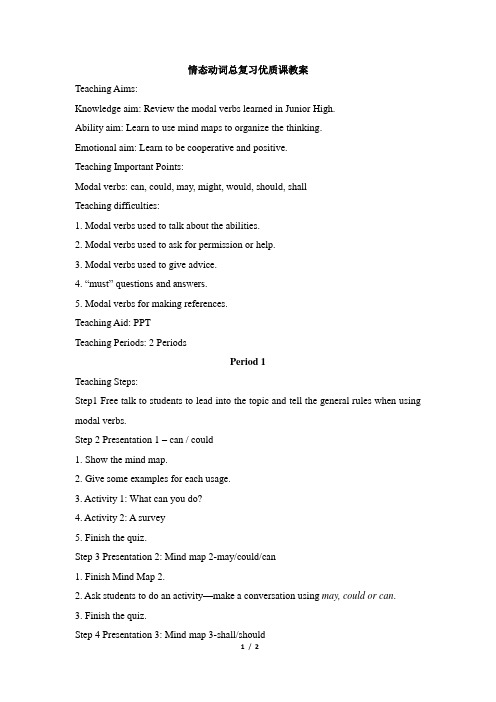
情态动词总复习优质课教案Teaching Aims:Knowledge aim: Review the modal verbs learned in Junior High.Ability aim: Learn to use mind maps to organize the thinking.Emotional aim: Learn to be cooperative and positive.Teaching Important Points:Modal verbs: can, could, may, might, would, should, shallTeaching difficulties:1. Modal verbs used to talk about the abilities.2. Modal verbs used to ask for permission or help.3. Modal verbs used to give advice.4. “m ust” questions and answers.5. Modal verbs for making references.Teaching Aid: PPTTeaching Periods: 2 PeriodsPeriod 1Teaching Steps:Step1 Free talk to students to lead into the topic and tell the general rules when using modal verbs.Step 2 Presentation 1 – can / could1. Show the mind map.2. Give some examples for each usage.3. Activity 1: What can you do?4. Activity 2: A survey5. Finish the quiz.Step 3 Presentation 2: Mind map 2-may/could/can1. Finish Mind Map2.2. Ask students to do an activity—make a conversation using may, could or can.3. Finish the quiz.Step 4 Presentation 3: Mind map 3-shall/should1. Finish the mind map with the students.2. Ask the students to do give some examples.3. Ask students to do the activity-sentence train.Step 5 SummaryStep 6 Homework1. Make a mind map for modal verbs can, could, may, must.Period 2Step 1 Review: Free talk to students and lead in the topic.Step 2 Presentation: Mind map 41. Finish the mind map with the students.2. Lecture about the u sage of “must” “need” “have to”, and emphasize on the yes-no questions with “must”.3. Activity: What rules do we need to make our school better?4. Finish the quiz with students.Step 3 Presentation: Mind map 51. Ask students to work in groups to finish the mind map.2. Check the answers with the students.3. Ask students to give examples for each usage.4. Finish the quiz with the students.5. Writing: Make references on your family’s activities.Step 4 SummaryAsk students to show the homework of last period—mind maps for modal verbs “ can”, “could” “ must” “may”, and correct their mistakes.Step 5 HomeworkFinish the exercises.。
- 1、下载文档前请自行甄别文档内容的完整性,平台不提供额外的编辑、内容补充、找答案等附加服务。
- 2、"仅部分预览"的文档,不可在线预览部分如存在完整性等问题,可反馈申请退款(可完整预览的文档不适用该条件!)。
- 3、如文档侵犯您的权益,请联系客服反馈,我们会尽快为您处理(人工客服工作时间:9:00-18:30)。
1 学员编号: 年 级:初三 课 时 数:学员姓名: 辅导科目:英语 学科教师:授课类型C 情态动词 星 级★★★ 教学目标 1、掌握情态动词can / could 、may,might 、need 等的用法;2、掌握情态动词must, may, might, can, could 等表示“推测”的用法。
(建议2-5分钟)批注:通过以上图片中出现的情况,请学生一次性说出以上这些情态动词各自所表达的含义,由此使学生对本课产生C 专题-情态动词You can ’t kiss me,you are a dog.They mustbefriends. They may be afamily.He needs go tosleep.This guy should eatless, he is so big.兴趣。
(建议20-25分钟)一、情态动词的类型1. 只作情态动词的有:must; can(could); may(might);2. 可作情态动词也可作实义动词的有:need;3.可作情态动词也可作助动词的有:will(would); shall(should);4. 具有情态动词的某些特征的有:have to; ought to.批注:关于对情态动词类型的分析,只能针对基础较好的学生,基础差的学生一般很难理解上述的总结:关于第三点的解释—will 和shall作助动词可以用于将来时的构成中,shall一般只用于主语是第一人称的时候,would 和should则为过去将来时的构成;关于第四点的解释—have to 是有时态和三单形式的变化的,ought to 在变疑问句和否定句时,to 是被排除在外不作考虑的。
二、情态动词的特征1. 有一定的词义,但不能单独作谓语,必须和行为动词或系动词连用,构成谓语。
2. 无人称和数的变化(have to例外,用于第三人称单数时用has to).例:We must stay here.我们必须待在这儿。
He must stay here.他必须待在这儿。
We have to walk home.我们不得不步行回家。
He has to walk home.他不得不步行回家。
3. 后接动词原形,即不带to的不定式。
She may lose her way.24. 具有助动词的作用,可用来构成否定句、疑问句及用于简明答语。
例:--Can you sing an English song? 你会唱英文歌么?--Yes, I can. 是的,我会。
批注:情态动词的基本特征,对于基础不错的学生而言,已经掌握得很清晰了,在这里着重讲解哪些具备情态动词某些特征的单词进行讲解,如:have to, ought to.三、情态动词的用法(一)can, could的用法1. 表能力,意为“能、会”。
例:Can you play basketball? 你会打篮球么?2. 表怀疑、猜测,常用于否定句和疑问句中。
例:He can’t be in the room. 他不可能在房间里。
3. 表请求或允许,多用于口语中,意为“可以”,相当于may.例:You can(may) go now. 你现在可以走了。
4. could是can的过去式,可以表示过去的能力。
例:I can swim when I was seven years old.我七岁时就会游泳。
5. 以can开头的一般疑问句,其肯定回答和否定回答分别用can和can’t.批注:相对而言,can 表示猜测的用法更为常考些,尤其要注意此时的can 不能用在肯定句中,老师在讲解时可以先把may表示猜测的用法拿出来与之比较一下,这样更有利于学生对于can表示猜测不能用在肯定句中印象更深刻些。
当然,也要强调can 的其他用法还是可以用在肯定句中的。
典例讲解–Look at the boy running on the ground. Is it David?-- It ______ be him. I saw him go to the teacher’s office just now.A. mustB. can’tC. couldD. might【答案】B(二)may的用法31. 表推测,意为“可能,也许”,用于肯定句中。
He may come tomorrow. 他明天可能会来。
2.表请求、许可,意为“可以”。
例:May I borrow your book? 我可以借用你的书么?注意:may表请求,用于主语为第一人称的一般疑问句时,其否定回答用mustn’t或can’t, 不用may not, 意为“不可以,不允许,禁止”。
例:--May I go now? 我现在可以走了么?--No, you mustn’t. 不,不可以。
3. 表祝愿May you succeed.祝你成功。
4. can 和may均可用来表示征求意见或允许,意为“可以”,一般可互换使用。
批注:may 表示猜测,区别于can 的最大特点就是may一般都用于肯定的(不太确定的)推测;但may表示请求许可的用法也是经常考的,特别是may引起的一般疑问句,其回答需要注意:肯定回答可以使用may或者can 都可以,但否定回答则不能用may not, 只能用can’t 或者mustn’t.典例讲解3. –May I go surfing alone this afternoon, Dad?--No, you ________. It is dangerous.A. may notB. can’tC. needn’tD. don’t【答案】B(三)must的用法1.表示“必须、应该”。
2. 表示推测,意为“一定”,一般用于肯定句。
在疑问句和否定句中一般应用can,否定句中也用may,但may not 表示“可能不”,而can’t表示“不可能”。
在否定句中,mustn’t表示禁止,意为“不允许”。
–There’s someone knocking on the door. 有人敲门。
–It must be Jim. 肯定是吉姆。
3. 以must开头的疑问句,肯定回答应用must,而否定回答则常用needn’t或don’t have to,意为“不需要、不必”,45 而不能用 mustn ’t 。
例:–Must I finish the work today? 我必须今天完成这项工作么?--No, you needn ’t. 不,不必。
批注:讲解must 的用法时,建议从汉语意思入手,“一定”和“必须”。
1) 作“一定”解时,must 的用法是表示肯定推测,而且只能用于肯定句中表示肯定推测,而很多学生总是认为,must 表示“一定”,那么“mustn ’t ”就是“一定不”的意思,那么最简单的方式就是告诉学生:英语中只有“一定”的表达方式,根本就没有“一定不”这样的表达方式,如果需要表示否定推测,用“can ’t ”即可。
2) 作“必须”解时,must 的含义有两种,一种是命令,一种是自身的主观意识,相当于“应该should ”,这两种用法比较容易理解,学生出错的概率比较低。
1. When traffic lights are red, we ________ stop and wait. (2007南京)A. mayB. canC. mustD. might【答案】C2. –Must I hand in my exercise book, Mr. Zhao?-No, you _______.A. needn ’tB. mustn ’tC. can ’tD. may not 【答案】A(四)对need 词性的判断need 做实义动词时:1)need 后加to do 表示“需要(主动)去做”,用助动词提问或否定;2)need 后加doing 表被动,“需要(被)做”,用助动词提问或否定;need 做情态动词时: need 后加动词原形,用need 提问或否定,肯定回答用must ,否定回答用needn ’t.例:You needn ’t come to school so early.你不必这么早来学校。
批注:其实need 真正作为情态动词去考察时比较简单,就是否定形式“needn ’t 没必要”,这种考察方式学生很少出错。
Need 考察频率最高的其实是:区分其两种用法;区分need 作实义动词时后面接to do 和doing 的异同。
所以讲解时要针对这两点进行细致分析。
–I was told to be here before eight.--Oh, you ______. I’m sorry for not telling you that we have changed the plane.A. mustB. can ’tC. mayD. needn ’t【答案】D典例讲解典例讲解(五)had better 的用法had better+动词原形,表示最好做某事,否定式用had better not do sth.。
例:You’d better stay at home.你最好待在家里。
You’d better not watch TV every day.你最好不要天天看电视。
批注:had better 具备情态动词的基本用法,但是平时的练习中学生还是容易忽略其后接动词原形的用法,特别是在加上not 之后,可以正式跟学生说清楚,had better 是情态动词,not 不能放在had后面,而必须放在better 后面。
(六)shall(should), will(would)的用法1. shall 用于第一人称,表示征求意见、询问。
例:Shall I open the window? 我打开窗户好么?Shall we have lunch here? 我们在这儿吃午饭好么?2. should 常用来表示义务、责任。
例:We should obey traffic laws. 我们应该遵守交通规则。
3. will用于第二人称表示询问、请求,也可以表达现在的“意愿”。
例:Will you pass me the book? 你能把那本书递给我么?We will do anything for you. 我们会为你做任何事。
4. would 用来表示过去的意愿或者委婉的询问。
例:Would you tell me the way to the station? 你能告诉我去车站的路么?批注:这几个词中,考察相对较多的还是should表示“应该”的用法, 但最近初三也出现了should 表示较大可能性的推测的用法,还是作“应该”解,但不是责任与义务上的应该,而是推测。
